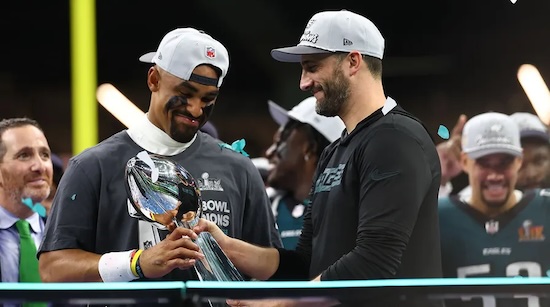
Two years ago, the Kansas City Chiefs defeated the Philadelphia Eagles 38–35 in Super Bowl LVII. A last second field goal put the cherry on top and started a winning campaign many thought would end in the first “three-peat” in the Super Bowl era of the NFL. Well, they thought wrong.
After dominant regular season and postseason performances from both teams, this matchup was as highly anticipated as it gets. Two juggernauts, one rematch on the biggest stage. How could it not be a battle for the ages? We’ll give you two reasons: Jalen Hurts, and the Eagles’ defense.
Traditionally, analyzing a football game means looking at what both teams did; but for this specific case, it only makes sense to analyze the Eagles. The Eagles defense, under new defensive coordinator Vic Fangio, showed up, to say the least.
If you were able to tune into the game at a time when Patrick Mahomes was under center, you would be able to tell that almost every throw he made came while he was under pressure. Usually, the reason for this is that the defense is blitzing. But if you took your eyes away from the quarterback and moved them to the line of scrimmage, you would see only four rushers, meaning there was no blitz at all. A defensive interior made up of young stars like Jalen Carter, Jordan Davis, and Milton Williams, as well as an edge rushing group consisting of Josh Sweat, Nolan Smith Jr., and veteran Brandon Graham, allowed Philadelphia to get consistent pressure without ever needing to blitz. So they didn’t—not once. And yet, they were still able to completely disrupt Patrick Mahomes.
When Mahomes did get a throw off, due to great performances by Eagles defenders in coverage, he made mistakes. Rookie Cooper DeJean had a pick-six, breakout linebacker Zack Baun had an interception that led to a touchdown, and overall, Mahomes uncharacteristically missed the easy passes.
While Philadelphia’s defense shut down Mahomes and the Chiefs, the offense had to ensure that their efforts were rewarded. Heading into the game, nearly every sports pundit insisted that the Eagles pound the rock, playing through Offensive Player of the Year Saquon Barkley, who, during this game, set the all-time record for most rushing yards in a single season, postseason included. However, all the Eagles needed to do was threaten Kansas City’s defense with a run to get them off their rhythm before Jalen Hurts carved up the Red and White’s secondary.
Both Jalen Hurts and Saquon Barkley are more than capable with their legs. Between Barkley’s record-breaking season and Hurts’ dual-threat capabilities, the Chiefs had to prepare adequately for the run. Defensive Coordinator Steve Spagnuolo needed a strong game plan to combat the run, and for what it’s worth, he did a good job doing so. Barkley only rushed for 57 yards, his second-lowest total all season long. However, the Eagles allowed the danger of the run game to influence the Chiefs’ play-calling, and they seized their opportunities to spread the field with their barrage of elite pass-catchers. A.J. Brown and DeVonta Smith both snagged receiving touchdowns, Jahan Dotson nearly had one as well, and Dallas Goedert was there for Hurts when he needed it. The Chiefs dared Hurts to pass the ball, and he did so for 221 yards, 2 touchdowns, and a deserved Super Bowl MVP trophy.
On the other side of the field, the Kansas City Chiefs may have been the eighth team to win back-to-back Super Bowls, but they could not capture the crown of being the first team in league history to grab three straight. While it has been an impressive year for head coach Andy Reid and company, this loss looms large as they head into the offseason. In the last six seasons, where they’ve reigned over the AFC and played in five Super Bowls, it’s not crazy to claim that this might have been the worst game they’ve played in this era of Chiefs football.
It certainly was the worst playoff performance we’ve seen out of Patrick Mahomes. In only his fourth playoff loss of his career, he tied his career high in the playoffs with two interceptions, both of which were generated by pressure from the Eagles’ defensive line. While he may have finished with 257 passing yards, most of these came in garbage time, when Philadelphia boasted 4-5 score leads and had taken out most of their star players. Even when the Chiefs fell to the Tampa Bay Buccaneers in Super Bowl LV, Mahomes’ acrobatics and production with his legs made up for the lack of protection and recorded stats. This time, he was simply outplayed by the Eagle’s defense. The sports media will likely eat him alive this offseason after his abysmal performance.
And with that, the 2024–25 NFL season comes to a close. Broad Street is in shambles, with rejoicing Philadelphia fans taking to the streets last night to climb up light posts and street signs in celebration. Chiefs fans hang their heads in disappointment. For every other franchise, the offseason has begun, as head coach signings, free agency, and the NFL Draft await. Each team will look to replicate what the Eagles were able to accomplish last offseason, signing an MVP candidate in Barkley, a Defensive Player of the Year candidate in Baun, drafting two Defensive Rookie of the Year candidates in Quinyon Mitchell and DeJean, and signing coordinators Kellen Moore and Fangio, who changed their playbook and led them to a ring.
Regardless of what happens over the next couple of months, and however the NFL landscape may change, NFL fans can all agree: Next season can’t come soon enough.
Max Forstein can be reached at mforstein@wesleyan.edu.
Harry Freeland can be reached at hfreeland@wesleyan.edu.


Leave a Reply